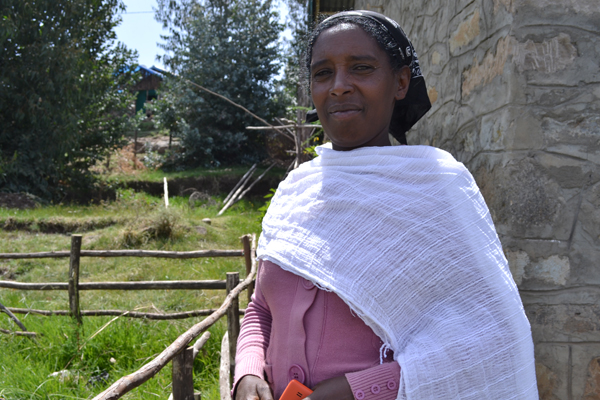Kathryn Burnham | September 4, 2017
The village offices of Bakelo kebele are perched midway up a hill, and small fields dot the land above, below, and all around. In the weeks before the fava bean planting season, the area is busy with farmers preparing for planting, and planning the many steps that are needed to start the season on the right foot.
Askale Kasaye has ploughed her field twice. She will do the third tillage and plant her seeds in a few weeks. She explains: “Traditionally, we only plough the field once and broadcast seeds. But I was trained by the agricultural bureau, so I know the importance of ploughing three times. It’s important to plough three times to kill diseases, pests, and weeds.”
Ploughing is very much a part of land preparation in Ethiopia, particularly in Debre Birhan woreda, 140 kilometres north of the capital, Addis Ababa. Farmers plough to manage diseases and pests. Some also attach a broad bed and furrow maker to their plough to manage excess moisture in waterlogged soils.
Mrs. Kasaye is using composted manure to give her fava beans the best soil possible. She makes her own by placing crop residues, extra fodder, leaves, and cow dung in a pit.
The pit measures four metres by four metres. She waters it every day for 15 days before mixing the composted manure. It’s a labour-intensive process.
Negesse Woldemariam is the local development agent. He says, “Farmers in this area are doing everything they can to improve their soil fertility.” Making composted manure is just one technique.
Mrs. Kasaye will spread the composted manure before the third ploughing, so that the plough incorporates it into the soil.
When she plants, Mrs. Kasaye drops the seeds in rows. She explains, “When we are doing the first [row], I will follow behind the plough, dropping the seed…. When we plough the next row, the plough will push soil over the seeds.”
The recommended spacing for fava bean plants is 20 centimetres apart, with 40 centimetres between rows. Mrs. Kasaye explains that 20 centimetres is about the distance between the tips of her thumb and forefinger, when her hand makes an “L” shape. Planting in rows will increase her yield.
Many farmers in Debre Birhan woreda own several small fields, and these dot the hill and valley. Mr. Woldemariam explains, “In this area, the soil can vary a lot from place to place. Plots on the hills, at higher elevation, will have different soils than plots lower down or in the valley.”
Johannes Kelile is another farmer who lives in Bakelo kebele. He says farmers choose their seeds based on soil conditions. If they need seeds for a particular type of soil—such as a waterlogged vertisol—they exchange seeds with other farmers.
Mr. Kelile says that farmers do not plant fava beans on the same fields every year, because the harvest diminishes each season with continuous beans. Instead, they rotate their crops, planting beans on land that previously grew a grain like wheat or barley. This is partly because the fertilizers used to grow wheat or barley improve the soil for fava beans. In turn, fava beans fix nitrogen in the soil, helping the next grain crop.
Fava beans are both a staple and a market crop for these farmers, and are featured in many dishes, including the popular shiro.
Mrs. Kasaye will plant a quarter-hectare of fava beans and, thanks to good land preparation, she hopes to harvest 10 quintals, or one tonne, in November.
